The Desktop Kabini Review Part 1: AMD Athlon 5350 (AM1) Tested
by Ian Cutress on April 9, 2014 8:00 AM ESTIGP Comparison, Synthetics
AMD’s graphics stack from top to bottom is all based on the Graphics Core Next architecture. This is an update from earlier VLIW implementations, offering for scalability from low power all the way up to high performance. At the heart of an AMD graphics system is the compute unit comprising of 64 GPU cores. Each compute unit can act independently, ensuring that multiple tasks can complete as quickly as possible due to multiple kernel dispatch across the entire core. In the Kaveri APU launch we were dealing with APUs that contained 6 or 8 compute units for 384/512 cores. With this level of performance, gaming at 1080p30 was possible on most titles depending on how the quality settings were configured. For Kabini, the entire range is given two compute units, with individual processors differing in clock speed.
With two compute units, we are not expecting much from the gaming aspect of these APUs in terms of ‘the latest’ titles. Our benchmarks in the next few pages show that even F1 2013 at 1280x1024 on low settings, unless the engine powering the game is basic, 25 FPS minimum is a hopeful target. This lack of horsepower may limit these APUs to Flash based titles, perhaps even some of the more reasonable Unity games. In AMD’s slide deck they quote games such as Minecraft, Lego Marvel Superheroes and Bastion as the sort of titles that a Kabini player should aim for.
There is some confusion regarding the naming convention of these integrated graphics solutions. Soldered on Kaveri parts designed for all-in-ones, such as the A6-5200, use the HD8000 naming scheme, such as the HD8400. The Athlon 5350 is analogous in design to the A6-5200 except for a 50 MHz speed bump and the name of the IGP – here this is designated as the R3 series. This is despite retailers who are currently selling this APUs and labeling them with the HD8000 designations.
Like Kaveri, the integrated graphics solution in Kabini features an updated Video Codec Engine and Unified Video Decoder giving hardware support for H.264.
AMD is also promoting their Picture Perfect solution, using additional post processing tools to increase video quality on the fly:
Also rather interestingly AMD is claiming an enhanced decoder for JPEG files. Given that one of the primary uses for a Kabini system might be for web access where JPEGs are standard, AMD has been promoting up to a 2x performance increase over a J2900 system:
AMD’s secret sauce, according to their slides, appears to be heterogeneous computing. This would be the ideal usage scenario for computing going forward.
GPU Synthetics
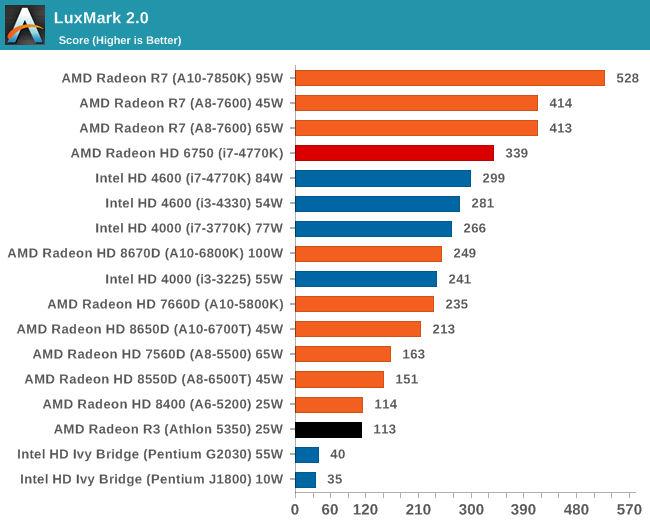
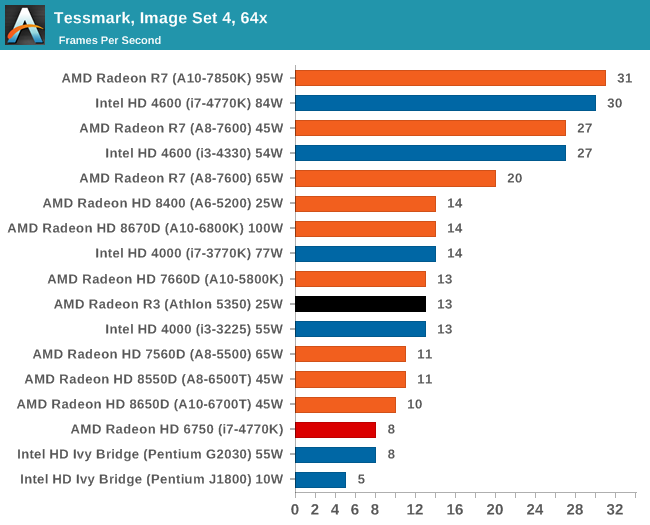


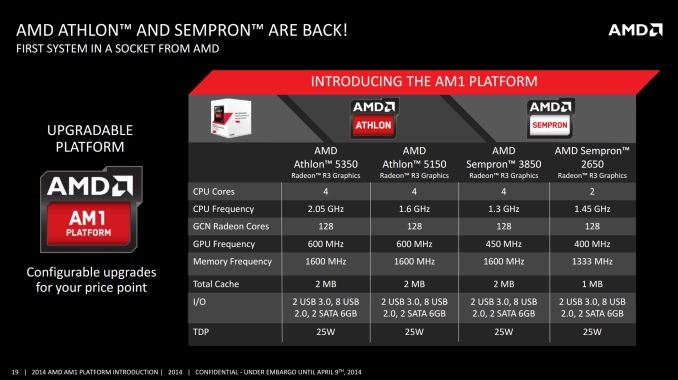
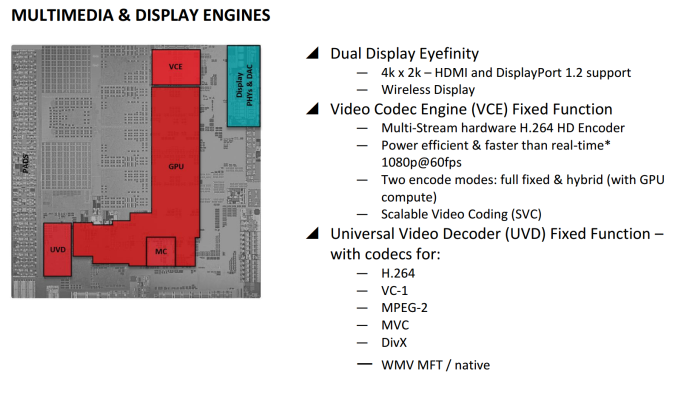
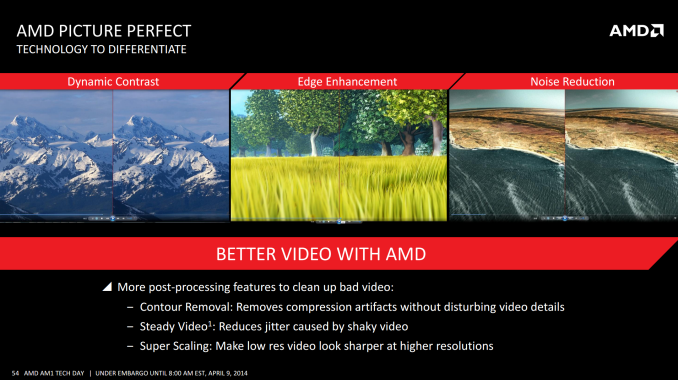
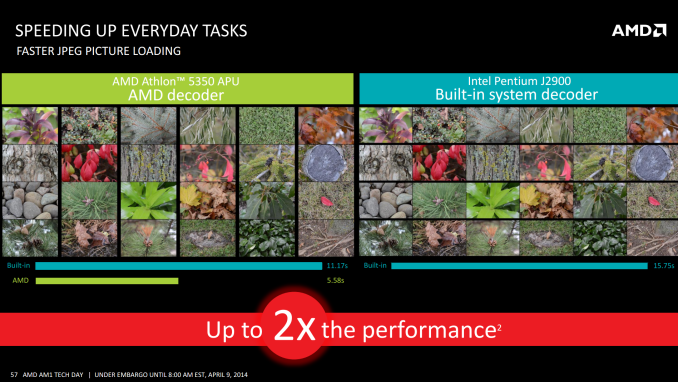
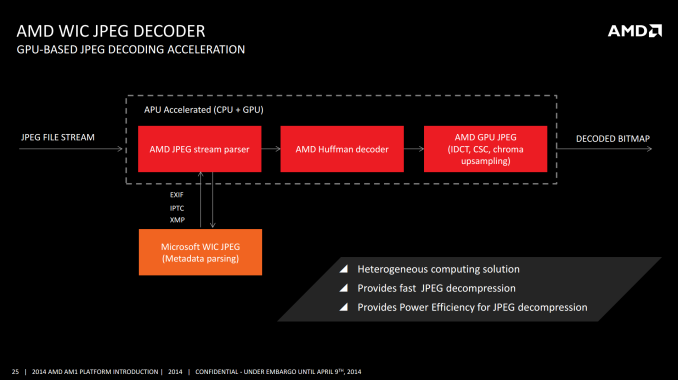








126 Comments
View All Comments
5thaccount - Thursday, April 10, 2014 - link
100% agree. Any Core 2 or newer based system with plenty of memory and an SSD will work fine for most users out there (the ones that use office, browse the web, and watch youtube)... and for quite a few years to come. Heck, I'm still using my E5200 daily after 6 years. Works perfect! Even looking at these benchmarks, the new Kabini is slower than a Core 2 Duo E8400. Which, oddly enough, can be picked up for under $20 on eBay... now that's a deal!jonathanharrison - Thursday, April 10, 2014 - link
I got a whole Vostro 200 system used with 20" widescreen LCD, 4GB DDR2 RAM (667), Core 2 Duo E6550 from a dude on Craigslist for a mere $45. Wife had gone to the Mac side and wanted the system out of the house ASAP. That's one way to do it - all but GIVE it away :)On-board intel graphics kinda don't cut it for gaming, so... when I could, I added a Sapphire Radeon HD 7770 GHz Edition 1GB video card ($109) and a 550W ThermalTake power supply ($40) into it and plugged it also into my other 20" monitor with a HDMI-DVI cable ($8) for a nice dual display... may go triple-head when I can afford to... wireless mouse/keyboard set ($30), Logitech gamepad F310, ($25)... and I've got a pretty nice light/older (DX9/10) gaming system for less than $220 of new purchases...
trueserve - Friday, April 18, 2014 - link
"A CPU only holds value if it is overclockable and the motherboard supports overclocking the processor."wat.
mikato - Friday, April 11, 2014 - link
Yeah, I had a Core 2 Duo E7300 in my wife's gaming system, and then when the latest COD came out with higher requirements, I bought a nice GTX 760 video card to put in there (with bigger PSU), and a better Core 2 Duo E8500 on ebay to go with it. Unfortunately the CPU was still really limiting things though, even after overclocking as much as I could, so in the end I had to build a new system around the video card... got an i5 4670K. But your point is valid. The system was used for HTPC tasks, XBMC, Skype, etc as well and the Core 2 Duos performed just great in everything besides the latest COD game, which is apparently a resource hog.phoenix_rizzen - Wednesday, April 9, 2014 - link
Wouldn't the PCIe x4 slot be the bigger bottleneck?nathanddrews - Wednesday, April 9, 2014 - link
PCIe 3.0 x2 = PCIe 2.0 x4 = PCIe 1.0 x8 = 2GB/sechttp://www.anandtech.com/show/5458/the-radeon-hd-7...
Even with just a PCIe 2.0 x4 electrical, it would still be massively CPU-bound. I wonder if any other manufacturers will bother to do a fully enabled x16 slot?
extide - Thursday, April 10, 2014 - link
They can't, there simply arent enough lanes on the CPU. If they ditched the NIC and uses every single lane for graphics, you could have x8.nathanddrews - Thursday, April 10, 2014 - link
Ah yes, you are correct.jonathanharrison - Thursday, April 10, 2014 - link
Hey, I resemble that. I've got a Radeon HD 7770 GHz being underfed by a Core 2 Duo E6550. Used system bought for cheap then added the video card, purchased new. I guess the 7750 would have been more than enough, but hey, the 7770 was a steal at $109. How's that for a CPU/GPU imbalance? Hey... at least it's in the right direction for gaming. I'd rather be CPU-limited than GPU-limited any day. I can still run 99% of the games out there, and do so with rather high settings and at least 4X AA most of the time. Maybe not 60fps in all games, but in a lot of them, especially the older ones, and getting 30fps or close in some of the newest (like MKKE).etamin - Wednesday, April 9, 2014 - link
In the "key points" on the first page, you listed two SATA 3gbps ports, but the Gigabyte comes with 2x SATA III. The block diagram shows two "SATA 2/3". In any case, two SATA ports is extremely restrictive. If mSATA and/or secondary SATA controllers can be had for the same $35, this would make for a terrific micro media server.